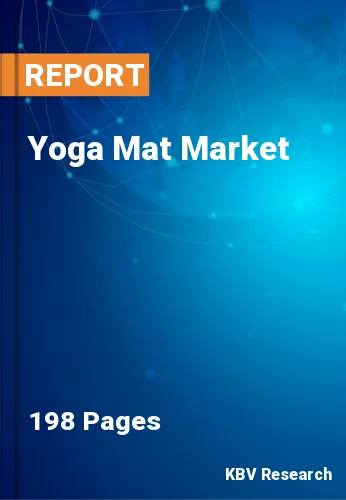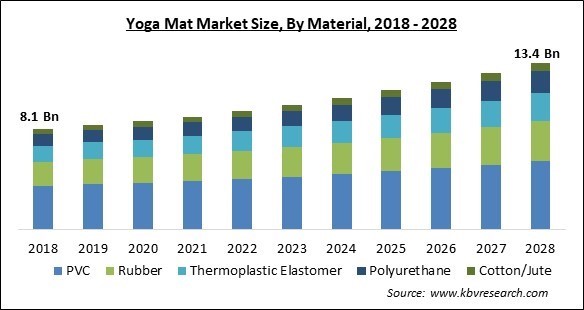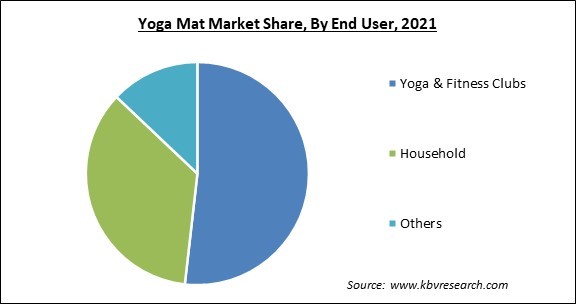
The Global Yoga Mat Market size is expected to reach $13.4 billion by 2028, rising at a market growth of 5.8% CAGR during the forecast period.
Modern yoga as exercise uses specially crafted mats called "yoga mats" to prevent hands and feet from slipping during asana practice. A sticky mat was an early version composed of rubber carpet underlay that was invented by yoga instructor Angela Farmer in 1982. Hatha and meditation yoga were traditionally practiced on bare ground, occasionally with a rug made of deer or tiger leather. Modern yoga mats are constructed of plastic, rubber, and occasionally other materials like hessian and cork, balancing price, grip, comfort, and weight. The phrase "one of the most pervasive emblems of yoga's commercialization" has been used to describe the yoga mat.

Although there are wider varieties, most yoga mats are 24 inches (60 centimeters) wide and 72 inches (182 centimeters) long. They range in thickness from 2 millimeters to 7 millimeters, with 4 to 5 millimeters being the most typical. These days, yoga mats come in a huge variety. They are available in a wide variety of hues, designs, and patterns. Some are made with the environment in mind, while others are made to be portable and usable anywhere.
Yoga mats come in a range of thicknesses, materials, surface textures, "stickiness" or grip, weight, and prices. They typically measure 6 feet (180 cm) long and 2 feet wide (61 cm). Yoga mats can be as thin as 116 inches (2 mm) for lightweight "travel" styles, as thick as 18 inches (3 mm) for normal mats, or as thick as 14 inches (6 mm) for either high-performing- performing mats or soft mattresses for yoga therapy. There are numerous colors and styles of mats available. The purpose of "alignment mats," which are printed with guidelines for proper alignment, is to assist practitioners in accurately spacing out and aligning their feet. Others have graphics printed on them. Some travel mats can be compactly squared up.
The original "sticky" yoga mats used in commercial production had a smooth surface and were typically less expensive; they were composed of PVC. More recently, some allegedly "green" mats have been created using rubber, organic cotton, and natural jute. PVC mats are the most pliable and have the most "give" when stepped on; cotton and jute fiber mats are the firmest. The roughest mats are made of jute; "sticky" PVC mats provide strong traction, but some contemporary textured mats made of various materials also offer high traction.
Nearly every country across all areas, their economic efficiency, and the distribution systems of every industry have all been impacted by COVID-19 in direct and indirect ways. The pandemic has, however, had a favorable effect on the health industry and its related business. The marketplaces for exercise equipment and medical supplies include the yoga mat business. The world market for yoga mats has not been adversely affected by the pandemic. People are getting more inventive these days and incorporating yoga into their workout routines. Numerous consumer psychologists assert that consumers have been making purchases based on three needs: protection, entertainment, and connection.
The numerous health advantages of yoga have increased its popularity over the past few years. One of the most well-liked forms of exercise in the world has been considered to be yoga. The practice of yoga is gaining popularity, and June 21 is recognized as International Yoga Day. In the UK, "yoga" ranks among the top 15 most used words. The demand for yoga mats and other related items has increased as a result of its rising popularity. The yoga mat serves as a barrier between the body and the ground. This creates a thermo-insulation by preventing any loss of heat, charge, or energy from the body to the ground.

Government agencies from all over the world are urging producers to use eco-friendly materials while creating yoga mats. Yoga mat makers are switching from using PVC materials to a variety of eco-friendly materials such as cotton, jute, and many others to comply with strict government rules. Businesses like Manduka, Yoloha, Prana, Jade Yoga, and Tomuno, among others, are concentrating on employing materials that emit little carbon dioxide during production. Even though they may differ in terms of their features and the materials used to make them, they all share the ability to serve as an environmentally friendly replacement for conventional PVC yoga mats.
Yoga mats are made from a variety of basic materials, including natural rubber, polyvinyl chloride (PVC), thermoplastic elastomer (TPE), and polyurethane (PU). The polymers made from crude oil include polyvinyl chloride (PVC), thermoplastic elastomer (TPE), and polyurethane (PU). As a result, the price of crude oil directly affects the yoga mat market. Crude oil prices are always fluctuating, which hurts the entire supply chain for yoga mats. While OEMs and suppliers of yoga mats are focusing on boosting prices to increase profits, they are also suffering losses and losing customers. Therefore, the price volatility of raw materials hinders the expansion of the yoga mat industry.
Based on the Material, the Yoga Mat Market is divided into PVC, TPE, Rubber, Thermoplastic Elastomer, Polyurethane, and Cotton/Jute. The rubber segment witnessed a significant revenue share in the yoga mat market in 2021. The most environmentally friendly yoga mats available on the market are probably made of rubber. They are made with renewable natural rubber from rubber trees in a sustainable manner. Additionally, rubber yoga mats don't have additional components like EVA or other forms of synthetic rubber.
On the basis of the Distribution Channel, the Yoga Mat Market is segmented into Specialty Store, Departmental Store & Hypermarket, and Online Channel. The online channel segment registered a substantial revenue share in the yoga mat market in 2021. Due to the widespread use of smartphones and the internet, it is expanding quickly. Online shopping has been increasingly popular for several reasons, including its availability 24 hours a day, a wide range of choices, and the opportunity to compare prices. Most retailers, like Lululemon and Manduka, also have websites where customers may order products based on their needs.
By end-user, the Yoga Mat Market is bifurcated into Yoga & fitness clubs, Household, and others. The household segment witnessed a significant revenue share in the yoga mat market in 2021. It is due to the sit-ups, glute bridges, push-ups, and other exercises done at home. A mat will be a terrific addition to the home gym if include floor-based activities in routines. They work well for dynamic ab exercises like Russian twists and leg lifts, which exert strain on the lower back and involve contact with the floor.
| Report Attribute | Details |
|---|---|
| Market size value in 2021 | USD 9.1 Billion |
| Market size forecast in 2028 | USD 13.4 Billion |
| Base Year | 2021 |
| Historical Period | 2018 to 2020 |
| Forecast Period | 2022 to 2028 |
| Revenue Growth Rate | CAGR of 5.8% from 2022 to 2028 |
| Number of Pages | 198 |
| Number of Tables | 370 |
| Report coverage | Market Trends, Revenue Estimation and Forecast, Segmentation Analysis, Regional and Country Breakdown, Companies Strategic Developments, Company Profiling |
| Segments covered | Material, Distribution Channel, End User, Region |
| Country scope | US, Canada, Mexico, Germany, UK, France, Russia, Spain, Italy, China, Japan, India, South Korea, Singapore, Malaysia, Brazil, Argentina, UAE, Saudi Arabia, South Africa, Nigeria |
| Growth Drivers |
|
| Restraints |
|
Region-wise, the Yoga Mat Market is analyzed across North America, Europe, Asia Pacific, and LAMEA. The North America region acquired a substantial revenue share in the yoga mat market in 2021. Due to the significant consumer expenditure on yoga and fitness-related products in nations like the United States and Canada, the North American region is anticipated to account for a significant portion of the market. Additionally, the region's growing availability of yoga and fitness facilities contributes to an increase in yoga mat usage.
Free Valuable Insights: Global Yoga Mat Market size to reach USD 13.4 Billion by 2028
The market research report covers the analysis of key stake holders of the market. Key companies profiled in the report include Adidas AG, Lululemon Athletica, Inc., Hugger Mugger Company, Inc., Manduka, LLC, Prana (Columbia Sportswear Company), Aurorae, LLC, Ecoyoga Ltd., EuProMed s.r.o., Jade Yoga, and Yaazhtex.
By Material
By Distribution Channel
By End User
By Geography
The Yoga Mat Market size is projected to reach USD 13.4 billion by 2028.
Increase In Yoga's Popularity are driving the market in coming years, however, Price Volatility For Raw Materials restraints the growth of the market.
Adidas AG, Lululemon Athletica, Inc., Hugger Mugger Company, Inc., Manduka, LLC, Prana (Columbia Sportswear Company), Aurorae, LLC, Ecoyoga Ltd., EuProMed s.r.o., Jade Yoga, and Yaazhtex.
The PVC segment acquired maximum revenue share in the Global Yoga Mat Market by Material in 2021 thereby, achieving a market value of $5.5 billion by 2028.
The Yoga & Fitness Clubs segment is leading the Global Yoga Mat Market by End User in 2021 thereby, achieving a market value of $6.7 billion by 2028.
The Asia Pacific market dominated the Global Yoga Mat Market by Region in 2021, and would continue to be a dominant market till 2028; thereby, achieving a market value of $4.7 billion by 2028.
Our team of dedicated experts can provide you with attractive expansion opportunities for your business.
